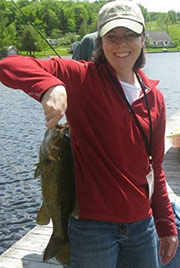Clowns of the sea: the Atlantic puffin
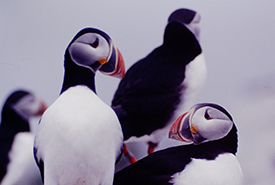
Atlantic puffins (Photo by Laurel Bernard/NCC staff)
The summer of 1999 was a unique one for me. I spent three months living on a small 23-acre (9.5 hectare) island 16 kilometres away from the nearest land. Machias Seal Island in New Brunswick was home to two full-time lighthouse keepers, three summer researchers and more than 10,000 nesting seabirds, including Atlantic puffins.
I watched Atlantic puffins nest, feed their young and watch the pufflings (yes, that is what young puffins are called) go off to sea at the end of the summer.
I was also lucky enough to return for a week in 2001 to volunteer with the researchers, with permission from my new employer — the Nature Conservancy of Canada (NCC).
Machias Seal Island is an interesting island. It sits almost equidistance from the coast of Maine and the coast of Grand Manan, New Brunswick. It is disputed territory between the United States and Canada, which dates back to the end of the American Revolutionary war. It is also a Government of Canada Migratory Bird Sanctuary. So, as we told some of the 1,000 birdwatching tourists who visited the island (via one of three boats permitted to land on the island), the island really belongs to the birds.
The main draw for these ecotourists was to see Atlantic puffins up close and personal (from within a blind). Puffins are known as the “clowns of the sea” because of their brightly coloured yellow and red bills and clown-like faces, but also because of their awkwardness on land. Their pudgy bodies are barely kept in flight by their stubby, frantically flapping wings. I was witness to some crash landings when a puffin didn’t quite make it to the rock it was aiming to land on.
However, it is in the sea that these birds shine. They are excellent swimmers, as they use their stubby wings as paddles to push themselves 30 to 60 metres deep into the ocean to catch fish. Their strong bills can clamp down on 10 fish (on average), which they then carry back to the surface and fly to their young, who wait in burrows in the ground.
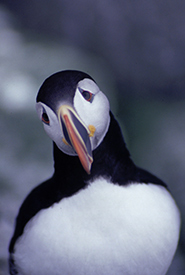
Atlantic puffins are curious birds. (Photo by Laurel Bernard)
I spent many an hour in a blind, meticulously recording each feeding, noting the number, size and species of fish brought in. The puffins were curious birds, and if I made noise in the blind they would hop over to see what was going on.
I also enjoyed listening to their chainsaw-like call echoing among the rocks and burrows — not really a sound you would expect a bird to make!
Social birds, puffins nest together in colonies. It is estimated that up to 260,000 pairs nest at Witless Bay on the island of Newfoundland. They nest on islands to be safe from predators, who could easily get into their burrows and eat their eggs and young.
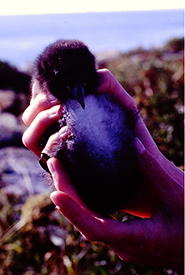
Me holding a young Atlantic puffin chick. (Photo by Laurel Bernard)
I must admit that the young were adorable. Grey balls of fluff with black bills and black webbed feet. We monitored their breeding success by first seeing which burrows had eggs. This was done by very carefully lying full out on the ground in front of a burrow and then sticking our arms down the burrow as far as they would go until we felt a soft puffin bum, then gently feeling under the bum for their single egg. Puffin bills can give a serious bite, so it was always an adventure as you never knew if an adult was home or not.
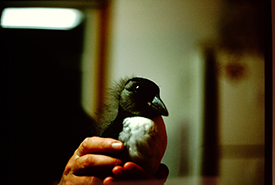
An Atlantic puffin fledgling (Photo by Laurel Bernard)
We kept track of which eggs hatched and which chicks made it to a certain age. Then came the really fun part. Puffin young are attracted to light, and a lighthouse nearby shined a bright light every night. Our nights in August were taken up with monitoring the grounds around the lighthouse for young puffins that would appear and wander around confused as they searched for the sea. We would scoop up the puffins, quickly weigh, measure and band them and then take them down to the sea and send them on their way. They would spend several years out at sea before returning to breed.
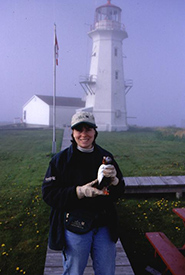
Me holding an Atlantic puffin in front of a lighthouse. (Photo courtesy of Laurel Bernard)
The research was part of a long-term study by the University of New Brunswick to look at the health of these populations, but to also use them as indicators of changes in the ecosystems. Seabirds are top consumers in marine food webs, and they provide research opportunities to detect and assess the biological effects of marine ecosystem changes. With the impacts of climate change, this is especially important.
That summer was a great opportunity to learn about these clowns of the sea and to immerse myself in the amazing life of puffins!
Want to support wildlife species and their habitat? With your donation, you are accelerating the pace of conservation and helping find solutions to the twin crises of rapid biodiversity decline and climate change. Learn more >

